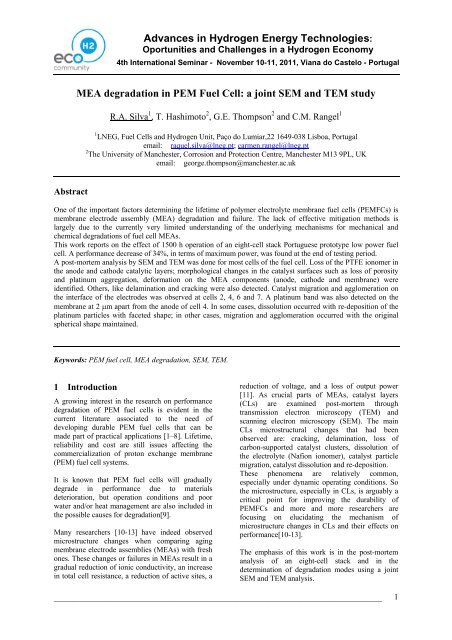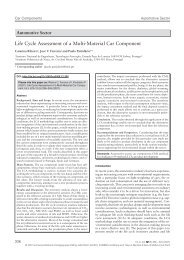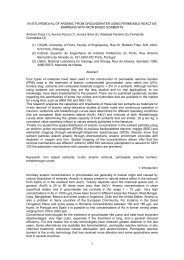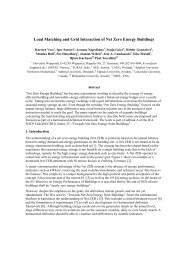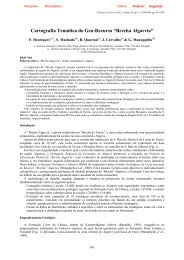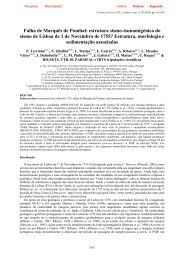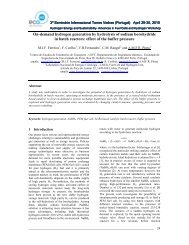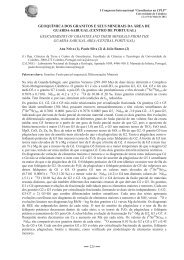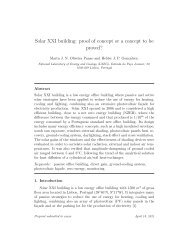MEA degradation in PEM Fuel Cell: a joint SEM and TEM study
MEA degradation in PEM Fuel Cell: a joint SEM and TEM study
MEA degradation in PEM Fuel Cell: a joint SEM and TEM study
Create successful ePaper yourself
Turn your PDF publications into a flip-book with our unique Google optimized e-Paper software.
Advances <strong>in</strong> Hydrogen Energy Technologies:<br />
Oportunities <strong>and</strong> Challenges <strong>in</strong> a Hydrogen Economy<br />
4th International Sem<strong>in</strong>ar - November 10-11, 2011, Viana do Castelo - Portugal<br />
<strong>MEA</strong> <strong>degradation</strong> <strong>in</strong> <strong>PEM</strong> <strong>Fuel</strong> <strong>Cell</strong>: a jo<strong>in</strong>t <strong>SEM</strong> <strong>and</strong> <strong>TEM</strong> <strong>study</strong><br />
R.A. Silva 1 , T. Hashimoto 2 , G.E. Thompson 2 <strong>and</strong> C.M. Rangel 1<br />
1 LNEG, <strong>Fuel</strong> <strong>Cell</strong>s <strong>and</strong> Hydrogen Unit, Paço do Lumiar,22 1649-038 Lisboa, Portugal<br />
email: raquel.silva@lneg.pt; carmen.rangel@lneg.pt<br />
2 The University of Manchester, Corrosion <strong>and</strong> Protection Centre, Manchester M13 9PL, UK<br />
email: george.thompson@manchester.ac.uk<br />
Abstract<br />
One of the important factors determ<strong>in</strong><strong>in</strong>g the lifetime of polymer electrolyte membrane fuel cells (<strong>PEM</strong>FCs) is<br />
membrane electrode assembly (<strong>MEA</strong>) <strong>degradation</strong> <strong>and</strong> failure. The lack of effective mitigation methods is<br />
largely due to the currently very limited underst<strong>and</strong><strong>in</strong>g of the underly<strong>in</strong>g mechanisms for mechanical <strong>and</strong><br />
chemical <strong>degradation</strong>s of fuel cell <strong>MEA</strong>s.<br />
This work reports on the effect of 1500 h operation of an eight-cell stack Portuguese prototype low power fuel<br />
cell. A performance decrease of 34%, <strong>in</strong> terms of maximum power, was found at the end of test<strong>in</strong>g period.<br />
A post-mortem analysis by <strong>SEM</strong> <strong>and</strong> <strong>TEM</strong> was done for most cells of the fuel cell. Loss of the PTFE ionomer <strong>in</strong><br />
the anode <strong>and</strong> cathode catalytic layers; morphological changes <strong>in</strong> the catalyst surfaces such as loss of porosity<br />
<strong>and</strong> plat<strong>in</strong>um aggregation, deformation on the <strong>MEA</strong> components (anode, cathode <strong>and</strong> membrane) were<br />
identified. Others, like delam<strong>in</strong>ation <strong>and</strong> crack<strong>in</strong>g were also detected. Catalyst migration <strong>and</strong> agglomeration on<br />
the <strong>in</strong>terface of the electrodes was observed at cells 2, 4, 6 <strong>and</strong> 7. A plat<strong>in</strong>um b<strong>and</strong> was also detected on the<br />
membrane at 2 μm apart from the anode of cell 4. In some cases, dissolution occurred with re-deposition of the<br />
plat<strong>in</strong>um particles with faceted shape; <strong>in</strong> other cases, migration <strong>and</strong> agglomeration occurred with the orig<strong>in</strong>al<br />
spherical shape ma<strong>in</strong>ta<strong>in</strong>ed.<br />
Keywords: <strong>PEM</strong> fuel cell, <strong>MEA</strong> <strong>degradation</strong>, <strong>SEM</strong>, <strong>TEM</strong>.<br />
1 Introduction<br />
A grow<strong>in</strong>g <strong>in</strong>terest <strong>in</strong> the research on performance<br />
<strong>degradation</strong> of <strong>PEM</strong> fuel cells is evident <strong>in</strong> the<br />
current literature associated to the need of<br />
develop<strong>in</strong>g durable <strong>PEM</strong> fuel cells that can be<br />
made part of practical applications [1–8]. Lifetime,<br />
reliability <strong>and</strong> cost are still issues affect<strong>in</strong>g the<br />
commercialization of proton exchange membrane<br />
(<strong>PEM</strong>) fuel cell systems.<br />
It is known that <strong>PEM</strong> fuel cells will gradually<br />
degrade <strong>in</strong> performance due to materials<br />
deterioration, but operation conditions <strong>and</strong> poor<br />
water <strong>and</strong>/or heat management are also <strong>in</strong>cluded <strong>in</strong><br />
the possible causes for <strong>degradation</strong>[9].<br />
Many researchers [10-13] have <strong>in</strong>deed observed<br />
microstructure changes when compar<strong>in</strong>g ag<strong>in</strong>g<br />
membrane electrode assemblies (<strong>MEA</strong>s) with fresh<br />
ones. These changes or failures <strong>in</strong> <strong>MEA</strong>s result <strong>in</strong> a<br />
gradual reduction of ionic conductivity, an <strong>in</strong>crease<br />
<strong>in</strong> total cell resistance, a reduction of active sites, a<br />
reduction of voltage, <strong>and</strong> a loss of output power<br />
[11]. As crucial parts of <strong>MEA</strong>s, catalyst layers<br />
(CLs) are exam<strong>in</strong>ed post-mortem through<br />
transmission electron microscopy (<strong>TEM</strong>) <strong>and</strong><br />
scann<strong>in</strong>g electron microscopy (<strong>SEM</strong>). The ma<strong>in</strong><br />
CLs microstructural changes that had been<br />
observed are: crack<strong>in</strong>g, delam<strong>in</strong>ation, loss of<br />
carbon-supported catalyst clusters, dissolution of<br />
the electrolyte (Nafion ionomer), catalyst particle<br />
migration, catalyst dissolution <strong>and</strong> re-deposition.<br />
These phenomena are relatively common,<br />
especially under dynamic operat<strong>in</strong>g conditions. So<br />
the microstructure, especially <strong>in</strong> CLs, is arguably a<br />
critical po<strong>in</strong>t for improv<strong>in</strong>g the durability of<br />
<strong>PEM</strong>FCs <strong>and</strong> more <strong>and</strong> more researchers are<br />
focus<strong>in</strong>g on elucidat<strong>in</strong>g the mechanism of<br />
microstructure changes <strong>in</strong> CLs <strong>and</strong> their effects on<br />
performance[10-13].<br />
The emphasis of this work is <strong>in</strong> the post-mortem<br />
analysis of an eight-cell stack <strong>and</strong> <strong>in</strong> the<br />
determ<strong>in</strong>ation of <strong>degradation</strong> modes us<strong>in</strong>g a jo<strong>in</strong>t<br />
<strong>SEM</strong> <strong>and</strong> <strong>TEM</strong> analysis.<br />
________________________________________________________________________ 1
Advances <strong>in</strong> Hydrogen Energy Technologies:<br />
Oportunities <strong>and</strong> Challenges <strong>in</strong> a Hydrogen Economy<br />
4th International Sem<strong>in</strong>ar - November 10-11, 2011, Viana do Castelo - Portugal<br />
2 Experimental<br />
An eight-cell stack with own designed flow field<br />
graphite plates, <strong>in</strong>tegrated <strong>in</strong> a series configuration<br />
was used <strong>in</strong> this work. The open cathode allows<br />
feed<strong>in</strong>g with air, which is designed to contribute to<br />
water removal <strong>and</strong> stack cool<strong>in</strong>g. An air fan located<br />
at the edge of the cathode manifolds was used to<br />
provide an excess air stoichiometry condition. The<br />
cells were fitted with a commercial <strong>MEA</strong> which<br />
uses Nafion 111.<br />
The stack was previously activated by a series of<br />
potentiodynamic <strong>and</strong> potentiostatic cycles before<br />
use [14]. Polarization curves were conducted, us<strong>in</strong>g<br />
an own purpose built <strong>PEM</strong> test station. Operat<strong>in</strong>g<br />
conditions used were optimized <strong>in</strong> previous work<br />
[15].<br />
The stack was subject to 12 experimental cycles<br />
after the activation procedure, correspond<strong>in</strong>g to<br />
total operation time of 1500h. A typical cycle is<br />
represented on figure 1.<br />
I / A<br />
4.5<br />
4.0<br />
3.5<br />
3.0<br />
2.5<br />
2.0<br />
1.5<br />
1.0<br />
0.5<br />
0.0<br />
0 6 12 18 24 31 41 51 61 71 81 91 101 111<br />
t/ m<strong>in</strong>.<br />
Fig. 1. A typical cycle to which the fuel cell was<br />
submitted, after the activation procedure.<br />
After a performance decrease of 34 % regard<strong>in</strong>g the<br />
maximum power the stack was dismantled for<br />
microstructural analysis. The aged <strong>MEA</strong>s cycled<br />
from the above described procedure were exam<strong>in</strong>ed<br />
by Transmission Electron Microscopy (<strong>TEM</strong>) <strong>and</strong><br />
Scann<strong>in</strong>g Electron Microscopy (<strong>SEM</strong>).<br />
Cross sections of the <strong>MEA</strong>s samples were observed<br />
for morphological <strong>and</strong> elemental composition<br />
changes us<strong>in</strong>g a Philips scann<strong>in</strong>g electron<br />
microscope, Model XL 30 FEG, coupled to an<br />
energy dispersive spectrometer, EDS, allow<strong>in</strong>g<br />
elemental mapp<strong>in</strong>g. <strong>SEM</strong> observation was<br />
conducted to <strong>study</strong> the morphological changes of<br />
the <strong>MEA</strong>, <strong>in</strong>clud<strong>in</strong>g thickness variations, crack<strong>in</strong>g,<br />
delam<strong>in</strong>ation, plat<strong>in</strong>um cluster<strong>in</strong>g <strong>and</strong> other<br />
changes which may decrease the stack voltage at a<br />
given dem<strong>and</strong>ed current, thus affect<strong>in</strong>g<br />
performance.<br />
<strong>TEM</strong> of <strong>in</strong>dividual cells of the studied stack was<br />
undertaken us<strong>in</strong>g a Tecnai F30 field emission gun<br />
<strong>in</strong>strument operated at an accelerat<strong>in</strong>g voltage of<br />
300 kV. Cross sections were prepared by<br />
ultramicrotomy us<strong>in</strong>g a Leica Ultracut UCT<br />
apparatus. Elemental analysis was performed with<br />
an Energy Dispersive X-Ray spectroscopy system<br />
attached to the microscope.<br />
3 Results<br />
Jo<strong>in</strong>t analysis of <strong>SEM</strong> <strong>and</strong> <strong>TEM</strong> results allowed<br />
detailed <strong>in</strong>formation on micro <strong>and</strong> macro structures,<br />
as well as the chemical composition of the<br />
materials <strong>and</strong> components after a reduction <strong>in</strong><br />
performance of 34 %, regard<strong>in</strong>g maximum power,<br />
<strong>in</strong> the fuel cell under <strong>study</strong>.<br />
This <strong>in</strong>formation is vital for the cont<strong>in</strong>ued<br />
development of all the components constitut<strong>in</strong>g a<br />
fuel cell stack <strong>and</strong> for underst<strong>and</strong><strong>in</strong>g how these<br />
components <strong>in</strong>teract <strong>and</strong> change under different<br />
operat<strong>in</strong>g conditions. This <strong>in</strong>formation is used when<br />
predict<strong>in</strong>g <strong>and</strong> optimiz<strong>in</strong>g stack performance <strong>and</strong><br />
lifetime.<br />
3.1 Scann<strong>in</strong>g electron microscopy<br />
<strong>SEM</strong> is a common tool for morphology analysis of<br />
catalytic layers which delivers high resolution<br />
surface images with a wide range of<br />
magnifications. Some important defects were<br />
observed when this technique was used.<br />
Typical results can be observed <strong>in</strong> Figure 2 for the<br />
anodic layer for cells 2, 4 <strong>and</strong> 7 which appear<br />
markedly different from the unused sample. Images<br />
were taken at 25000 X magnification.<br />
Surface area seems to be lost with cycl<strong>in</strong>g. After<br />
use <strong>and</strong> for all the cells, the catalytic layers present<br />
a more compact <strong>and</strong> less porous structure when<br />
compared with the unused layers. Part of the<br />
problem is probably result<strong>in</strong>g from the clamp<strong>in</strong>g<br />
forces to which the cells of the stack are subjected<br />
<strong>in</strong> the seal<strong>in</strong>g <strong>and</strong> assembly process. Compress<strong>in</strong>g<br />
the cathode might have contributed to alter the<br />
orig<strong>in</strong>al morphology. This was more evident for<br />
cell 8 for which it was not possible to peeled away<br />
the carbon paper.<br />
Another observation of the CLs us<strong>in</strong>g <strong>SEM</strong>, was<br />
the gas diffusion layer (GDL) debris. After fuel cell<br />
dismantl<strong>in</strong>g process all the cells showed, on both<br />
anode <strong>and</strong> cathode, GDL residues that rema<strong>in</strong>s<br />
attached to the CLs.<br />
Figure 3 shows the GDL debris for cell 2 <strong>and</strong> cell 7.<br />
In the last cell of the stack, it was not possible to<br />
remove the GDL at the anode <strong>and</strong> it was very<br />
difficult to remove it at the cathode, leav<strong>in</strong>g carbon<br />
fibers from GDL attached to the catalyst surface.<br />
________________________________________________________________________ 2
Advances <strong>in</strong> Hydrogen Energy Technologies:<br />
Oportunities <strong>and</strong> Challenges <strong>in</strong> a Hydrogen Economy<br />
4th International Sem<strong>in</strong>ar - November 10-11, 2011, Viana do Castelo - Portugal<br />
a<br />
c<br />
Fig. 2 <strong>SEM</strong> anode surface morphology for cells 2 (a); 4<br />
(b), 7 (c) <strong>and</strong> unused sample (d).<br />
This observation corroborates the idea that a high<br />
assembly pressure was used <strong>in</strong> the assembly of the<br />
stack <strong>and</strong> caused the bipolar plate to press the GDL<br />
<strong>in</strong>to the catalyst layer. Whilst not the purpose of<br />
this <strong>study</strong>, it is considered important to f<strong>in</strong>d, <strong>in</strong> the<br />
future, an optimal torque for this stack design <strong>and</strong><br />
for the materials used on its construction,<br />
establish<strong>in</strong>g a compromise between the tightness of<br />
the stack, the contact resistance <strong>and</strong> the<br />
deformation of the different materials.<br />
(a)<br />
(b)<br />
Fig. 3 GDL debris at anodic layers of cell 2 (a) <strong>and</strong> <strong>Cell</strong> 7<br />
(b), after 1500 h of operation.<br />
Determ<strong>in</strong>ation of <strong>MEA</strong> components thickness was<br />
also carried out with <strong>SEM</strong>, on <strong>MEA</strong>s crosssections.<br />
Figure 4 shows for three <strong>MEA</strong> components<br />
(membrane, anodic <strong>and</strong> cathodic CLs) their<br />
thickness variation comparatively to the unused<br />
<strong>MEA</strong>. The cathode th<strong>in</strong>n<strong>in</strong>g occurs <strong>in</strong> all the cells<br />
be<strong>in</strong>g more evident for the cell that suffered the<br />
highest degree of <strong>degradation</strong> <strong>and</strong> for which the<br />
assembl<strong>in</strong>g pressure have more drastic<br />
consequences (<strong>Cell</strong> 8). The thickness variations<br />
have an effect on the resistance through the <strong>MEA</strong>s.<br />
The th<strong>in</strong>ner areas of the catalyst layer will have a<br />
lower electronic resistance, while the th<strong>in</strong>ner<br />
electrolyte areas lower ionic resistance.<br />
b<br />
b<br />
d<br />
Thickness variation relatively to<br />
the unused <strong>MEA</strong> /mm<br />
8<br />
6<br />
4<br />
2<br />
0<br />
-2<br />
-4<br />
-6<br />
Anode<br />
Membrane<br />
Cathode<br />
-8<br />
<strong>Cell</strong> 1 <strong>Cell</strong> 2 <strong>Cell</strong> 3 <strong>Cell</strong> 4 <strong>Cell</strong> 5 <strong>Cell</strong> 7 <strong>Cell</strong> 8<br />
Fig. 4 Thickness variation of <strong>MEA</strong> components for some<br />
of the stack cells, relatively to the unused <strong>MEA</strong>.<br />
The cathode of all cells showed a th<strong>in</strong>n<strong>in</strong>g which is<br />
more pronounced as the cells were farther to the<br />
hydrogen <strong>in</strong>let <strong>in</strong> the stack. <strong>Cell</strong> 8 showed a<br />
th<strong>in</strong>n<strong>in</strong>g of about 47% after all the tests. At the<br />
anodic layer the th<strong>in</strong>n<strong>in</strong>g is significant only for<br />
cells 7 <strong>and</strong> 8. The anode thickness th<strong>in</strong>n<strong>in</strong>g was<br />
lower than observed at the cathode, correspond<strong>in</strong>g<br />
to a decrease of about 21% for cell 8.<br />
Others microstructure changes <strong>in</strong> CLs were<br />
observed by <strong>SEM</strong>, cracks <strong>and</strong> delam<strong>in</strong>ation are<br />
some.<br />
A very common feature among all of the analyzed<br />
CLs is the crack<strong>in</strong>g. Figure 5 (a) shows a <strong>SEM</strong><br />
image of a cracked CL. The <strong>in</strong>tegrity of the CL is<br />
compromised by cracks, but leaves the Nafion TM<br />
membrane mechanically undamaged (fig. 5b).<br />
Thus, the fuel cell can still operate, but<br />
performance <strong>and</strong> durability may be reduced. On the<br />
other h<strong>and</strong>, the cracks will provide areas where the<br />
water could accumulate prevent<strong>in</strong>g reactant gases<br />
to reach the catalytic sites <strong>and</strong> consequently,<br />
reduces the reaction rate. Another important<br />
consequence is the catalyst erosion due to the<br />
exposure of the catalyst surfaces to agents such a<br />
water <strong>and</strong> gas flux.<br />
In addition to cracks through the electrode<br />
thickness, delam<strong>in</strong>ations between the electrode <strong>and</strong><br />
the membrane are real failure modes (fig. 5b). Even<br />
small delam<strong>in</strong>ations may affect the <strong>in</strong>tegrity <strong>and</strong><br />
mechanical response of the <strong>MEA</strong>. Evidence of<br />
delam<strong>in</strong>ation was seen <strong>in</strong> both fresh <strong>and</strong> aged<br />
samples, which may put the question of the<br />
<strong>in</strong>fluence of the method of preparation. However, it<br />
was more predom<strong>in</strong>ant <strong>in</strong> aged samples.This type<br />
of defect may result from <strong>MEA</strong> manufactur<strong>in</strong>g<br />
procedure but can also be <strong>in</strong>duced by the<br />
<strong>degradation</strong> of the catalytic layer. It forces the<br />
current to flow away from delam<strong>in</strong>ated zones,<br />
through neighbor<strong>in</strong>g regions <strong>in</strong> which heat is<br />
locally produced. As these neighbor<strong>in</strong>g zones are<br />
________________________________________________________________________ 3
Advances <strong>in</strong> Hydrogen Energy Technologies:<br />
Oportunities <strong>and</strong> Challenges <strong>in</strong> a Hydrogen Economy<br />
4th International Sem<strong>in</strong>ar - November 10-11, 2011, Viana do Castelo - Portugal<br />
also prone to water accumulation, they may<br />
degrade faster than other parts of the catalytic<br />
layers.<br />
(a)<br />
(b)<br />
Fig. 5 Scann<strong>in</strong>g electron micrograph of a catalyst layer<br />
with cracks (anode cell 7) (a). Cross section <strong>SEM</strong> view of<br />
the <strong>MEA</strong> for cell 7 show<strong>in</strong>g delam<strong>in</strong>ation (1) <strong>and</strong><br />
crack<strong>in</strong>g (2) (b).<br />
The compression force <strong>and</strong> the uniformity of the<br />
compression force between the l<strong>and</strong> <strong>and</strong> under the<br />
channel are further important factors to mitigate<br />
<strong>in</strong>terfacial damage. The compression force<br />
distribution under the channel is dependent of<br />
diffusion media material properties, the l<strong>and</strong> width,<br />
<strong>and</strong> assembly pressure. However, the compression<br />
force under the channel is significantly lower than<br />
that under the l<strong>and</strong> <strong>and</strong>, consequently, the possible<br />
maximum size of <strong>in</strong>terfacial delam<strong>in</strong>ation is likely<br />
to be the channel width.<br />
Another type of catalyst layer <strong>degradation</strong> found<br />
was the presence of plat<strong>in</strong>um clusters, which is<br />
evident <strong>in</strong> Figure 6. EDS analysis was performed<br />
on clustered areas, which were shown to be<br />
plat<strong>in</strong>um rich. A spectrum of a surround<strong>in</strong>g area,<br />
where clusters were not observed, is <strong>in</strong>cluded for<br />
comparison.<br />
C<br />
F<br />
O<br />
100 μm<br />
Si<br />
Pt<br />
Pt<br />
0 1 2 3<br />
Energy / keV<br />
Homogeneous Catalyst<br />
Pt cluster<br />
Fig. 6 Pt cluster on anodic layer C2, <strong>SEM</strong> <strong>and</strong> associated<br />
EDS on cluster <strong>and</strong> surround<strong>in</strong>g area.<br />
The high plat<strong>in</strong>um concentration could result from<br />
catalyst detach<strong>in</strong>g from the carbon support<strong>in</strong>g<br />
surface. The catalyst agglomeration leads to a<br />
S<br />
Cathode<br />
1<br />
Anode<br />
Pt<br />
2<br />
gradual decrease <strong>in</strong> the electrochemically active<br />
surface area, <strong>in</strong>creas<strong>in</strong>g <strong>in</strong> this way the activation<br />
loss. The presence Si has also been identified. The<br />
use of silicone pip<strong>in</strong>g <strong>and</strong> the seal<strong>in</strong>g gasket are<br />
believed to have <strong>in</strong>troduced Si contam<strong>in</strong>ation <strong>in</strong> the<br />
<strong>MEA</strong>.<br />
From the EDS results it is suggested that a severe<br />
<strong>degradation</strong> occurred on the PTFE ionomer used as<br />
a b<strong>in</strong>der <strong>in</strong> the catalytic layer, due the fluoride<br />
content loss.<br />
3.2 Tunnel<strong>in</strong>g electron microscopy (<strong>TEM</strong>)<br />
<strong>TEM</strong> supplies images of even higher magnification<br />
than the <strong>SEM</strong>, but it requires ultra th<strong>in</strong> sample<br />
specimen preparation. With a <strong>TEM</strong> <strong>study</strong> it was<br />
also possible to determ<strong>in</strong>e chemical identity,<br />
particle size <strong>and</strong> distribution <strong>and</strong> location of the lost<br />
catalyst <strong>in</strong> the <strong>in</strong>vestigated sample.<br />
One of the more significant causes of fuel cell<br />
performance <strong>degradation</strong> is the catalyst deactivation<br />
dur<strong>in</strong>g extended operation. <strong>TEM</strong> images were used<br />
to determ<strong>in</strong>e the electrocatalyst particle size <strong>and</strong><br />
distribution on the carbon support <strong>in</strong> order to try to<br />
evaluate which mechanism is responsible for the<br />
performance loss.<br />
For cell 2, migration of plat<strong>in</strong>um particles is evident<br />
<strong>in</strong> Figure 7a). The Pt-enriched zone was higher at<br />
the cathode CL/Nafion <strong>in</strong>terface, with an<br />
enrichment depth of about 100 nm. Accord<strong>in</strong>g with<br />
the EDS results for the anode <strong>and</strong> cathode areas,<br />
there is an <strong>in</strong>crement <strong>in</strong> Pt content (wt%) for the<br />
<strong>in</strong>terfaces (anode/membrane <strong>and</strong> cathode<br />
/membrane) of 55.5% <strong>and</strong> 84.3%, respectively.<br />
Probably this occurred by the Ostewald ripen<strong>in</strong>g<br />
mechanism, which <strong>in</strong>volves plat<strong>in</strong>um dissolution at<br />
the cathode, diffusion of the soluble plat<strong>in</strong>um<br />
species from small to large particles <strong>in</strong>to the<br />
<strong>in</strong>terface cathode/membrane, followed by<br />
redeposition of soluble Pt <strong>in</strong>to large particles<br />
(fig.7b).<br />
A r<strong>and</strong>om selection of 35 spherically shaped<br />
plat<strong>in</strong>um particles <strong>in</strong> the <strong>TEM</strong> images, revealed a<br />
more frequent Pt particle diameter of 3.75 nm for<br />
all the selected areas at the anodic catalyst layer.<br />
For the cathodic layer, the Pt particle diameter more<br />
frequent <strong>in</strong>creases from 2.94 nm to 3.53 nm, as the<br />
exam<strong>in</strong>ed area extends towards the membrane.<br />
Aparently, the plat<strong>in</strong>um particle shape was<br />
unchanged, suggest<strong>in</strong>g that a few Pt particles<br />
dissolved <strong>and</strong> migrate to the <strong>in</strong>terface where they<br />
agglomerate due to the thermodynamically<br />
<strong>in</strong>stability of the nanoparticles.<br />
Another feature observed by <strong>TEM</strong> was a presence<br />
of plat<strong>in</strong>um <strong>in</strong>side the membrane of cell 4, at 2 mm<br />
from the anode (fig. 8 a), which probably results<br />
from carbon corrosion at the cathode. The loss of Pt<br />
from the carbon support <strong>and</strong> the loss of electrode<br />
________________________________________________________________________ 4
Advances <strong>in</strong> Hydrogen Energy Technologies:<br />
Oportunities <strong>and</strong> Challenges <strong>in</strong> a Hydrogen Economy<br />
4th International Sem<strong>in</strong>ar - November 10-11, 2011, Viana do Castelo - Portugal<br />
activity are the ma<strong>in</strong> responsible for the<br />
performance decrease.<br />
(a)<br />
2 μm<br />
(a)<br />
100 nm<br />
20 nm<br />
5 nm<br />
(c)<br />
Membrane<br />
(b)<br />
20 nm<br />
Fig. 8 <strong>TEM</strong> micrographs of cell 4 obta<strong>in</strong>ed from the<br />
anodic side where a plat<strong>in</strong>um b<strong>and</strong> it is visible <strong>in</strong> the<br />
membrane (a). A high magnification image of one of<br />
these particles found <strong>in</strong>side the membrane (c). The<br />
possible mechanism that occurred (b).<br />
(b)<br />
Fig. 7 <strong>TEM</strong> micrographs of cell 2 obta<strong>in</strong>ed from cathode<br />
(a) locations near the membrane <strong>in</strong>terface. The<br />
mechanism probably responsible for the catalyst surface<br />
area loss (b).<br />
Hydrogen molecules can permeate through the<br />
proton-conduct<strong>in</strong>g membrane lead<strong>in</strong>g to a chemical<br />
reduction of any dissolved Pt that migrate through<br />
the membrane, result<strong>in</strong>g <strong>in</strong> deposition. (fig. 8b) The<br />
location of this Pt deposition <strong>in</strong> the membrane is<br />
dependent on the partial pressure of oxygen <strong>in</strong> the<br />
cathode. The higher the partial pressure of oxygen,<br />
the farther from the cathode the Pt deposition<br />
occurs. The deposited plat<strong>in</strong>um particle changed<br />
from the orig<strong>in</strong>al shape (spherical) now show<strong>in</strong>g a<br />
rectangular shape (fig. 8c) which, from the<br />
literature, is an <strong>in</strong>dicative of this mechanism<br />
[16,17] .<br />
Detachment of Pt nanoparticles from the carbon<br />
support <strong>and</strong> agglomeration of Pt nanoparticles is<br />
generally <strong>in</strong>duced by carbon corrosion, so probably<br />
this had also happened on the stack. Corrosion on<br />
carbon support consists on its oxidation to form<br />
carbon dioxide. The corrosion rate depends, among<br />
other factors, on the type of carbon, operat<strong>in</strong>g<br />
potential, temperature, humidity, <strong>and</strong> uniformity of<br />
fuel distribution.<br />
Carbon corrosion may occur:<br />
• dur<strong>in</strong>g the fuel operation at elevated<br />
temperatures [18] ;<br />
• with start/stop operation (occur<strong>in</strong>g on the<br />
cathode) [19] ;<br />
• <strong>Fuel</strong> starvation (occurr<strong>in</strong>g on the anode) [20].<br />
At anodic layer of cell 7, carbon particles are<br />
visible without any plat<strong>in</strong>um particles, suggest<strong>in</strong>g<br />
plat<strong>in</strong>um dissolution <strong>and</strong> further migration <strong>and</strong><br />
agglomeration <strong>in</strong>side the catalyst layer with larger<br />
sizes occurred (fig. 9). In this layer, void spaces <strong>and</strong><br />
brighter areas are also observed <strong>in</strong>dicat<strong>in</strong>g the<br />
possibility of carbon corrosion.<br />
Fig. 9 <strong>TEM</strong> micrographs of cell 7 obta<strong>in</strong>ed from <strong>in</strong>ner<br />
layer <strong>in</strong>side the anode.<br />
________________________________________________________________________ 5
Advances <strong>in</strong> Hydrogen Energy Technologies:<br />
Oportunities <strong>and</strong> Challenges <strong>in</strong> a Hydrogen Economy<br />
4th International Sem<strong>in</strong>ar - November 10-11, 2011, Viana do Castelo - Portugal<br />
F<strong>in</strong>al remarks<br />
Jo<strong>in</strong>t analysis of <strong>in</strong>dividual cells of a low power<br />
fuel cell stack us<strong>in</strong>g <strong>SEM</strong>, <strong>TEM</strong> <strong>and</strong> EDS was<br />
undertak<strong>in</strong>g <strong>in</strong> order to identify ma<strong>in</strong> degradadtion<br />
mechanisms after 34 % loss <strong>in</strong> performance.<br />
<strong>TEM</strong> allows direct imag<strong>in</strong>g <strong>and</strong> evaluation of<br />
<strong>in</strong>dividual constituents (carbon support, ionomer,<br />
electrocatalyst particles, <strong>and</strong> <strong>in</strong>terfaces between the<br />
electrode <strong>and</strong> membrane), while <strong>SEM</strong> allows the<br />
<strong>in</strong>vestigation of surfaces of the electrodes at higher<br />
magnifications which were useful for<br />
microstructural analysis.<br />
Thickness variation was verified on both CLs. The<br />
cathode of all cells showed a th<strong>in</strong>n<strong>in</strong>g which is<br />
more pronounced as the cells were located farther<br />
from the hydrogen <strong>in</strong>let <strong>in</strong> the stack. <strong>Cell</strong> 8 showed<br />
a th<strong>in</strong>n<strong>in</strong>g of about 47% after all the tests. At the<br />
anodic layer the th<strong>in</strong>n<strong>in</strong>g is mean<strong>in</strong>gful only for<br />
cells 7 <strong>and</strong> 8.<br />
The membrane thickness was unchanged.<br />
EDS results <strong>in</strong>dicated that severe <strong>degradation</strong><br />
occurred on the PTFE ionomer used as a b<strong>in</strong>der <strong>in</strong><br />
the catalytic layer, due to fluoride content loss.<br />
Changes <strong>in</strong> the CL surface were also observed,<br />
particularly particle coalescence <strong>and</strong> loss of<br />
porosity.<br />
Carbon corrosion <strong>and</strong> catalytic active area loss<br />
mechanisms associated to plat<strong>in</strong>um migration, or<br />
dissolution <strong>and</strong> re-deposition, were identified <strong>in</strong> a<br />
few samples. Further <strong>study</strong> is planned.<br />
References<br />
[1] B. C. H. Steele <strong>and</strong> A. He<strong>in</strong>zel. Materials for fuel-cell<br />
technologies, Nature 414 (2001) 345–352.<br />
[2] X. Cheng, L. Chen, C. Peng, Z. Chen, Y. Zhang <strong>and</strong> Q.<br />
Fan. Catalyst Microstructure Exam<strong>in</strong>ation of <strong>PEM</strong>FC<br />
Membrane Electrode Assemblies vs. Time, J. Electrochem.<br />
Soc. 151 (2004) A48–A52.<br />
[3] B. Avasarala, R. Moore <strong>and</strong> P. Haldar. Surface oxidation<br />
of carbon supports due to potential cycl<strong>in</strong>g under <strong>PEM</strong> fuel<br />
cell conditions, Electrochimica Acta 55(2010) 4765-4771.<br />
[4] J.Wu, X. Z. Yuan, J. J. Mart<strong>in</strong>, H. Wang, J. Zhang, J.<br />
Shen, S.Wu,W. Merida. A review of <strong>PEM</strong> fuel cell<br />
durability: Degradation mechanisms <strong>and</strong> mitigation<br />
strategies, J. Power Sources 184 (2008) 104–119.<br />
[5] K. J.J. Mayrhofer, J. C. Meier, S. J. Ashton, G.K.H.<br />
Wiberg, F. Kraus, M. Hanzlik <strong>and</strong> M. Arenz. <strong>Fuel</strong> cell<br />
catalyst <strong>degradation</strong> on the nanoscale, Electrochem.<br />
Commun. 10 (2008) 1144–1147.<br />
[6] W. Yoon <strong>and</strong> X. Huang. Study of Polymer Electrolyte<br />
Membrane Degradation under OCV Hold Us<strong>in</strong>g Bilayer<br />
<strong>MEA</strong>s, J. Electrochem. Soc. 157(2010) B599-B606.<br />
[7] M.A. Rubio, A. Urquia <strong>and</strong> S. Dormido. Diagnosis of<br />
performance <strong>degradation</strong> phenomena <strong>in</strong> <strong>PEM</strong> fuel cells.<br />
Internat. J. .Hydrogen Energy 35 (2010) 2586-2590.<br />
[8] P Rama, R Chen <strong>and</strong> J Andrews. A review of<br />
performance <strong>degradation</strong> <strong>and</strong> failure modes for hydrogenfuelled<br />
polymer electrolyte fuel cells, J. Power <strong>and</strong> Energy<br />
222 (2008) 421-441.<br />
[9] W. Schmitt<strong>in</strong>ger, A. Vahidi. A review of the ma<strong>in</strong><br />
parameters <strong>in</strong>fluenc<strong>in</strong>g long-term performance <strong>and</strong> durability<br />
of <strong>PEM</strong> fuel cells. J Power Sources 180 (2008) 1–14.<br />
[10] S. Kundu, M.W. Fowler, L.C. Simon <strong>and</strong> S. Grot.<br />
Morphological features (defects) <strong>in</strong> fuel cell membrane<br />
electrode assemblies, J. Power Sources 157 (2006) 650–656.<br />
[11] J. Xie, I.D.L. Wood, K.L. More, P. Atanassov <strong>and</strong> R.L.<br />
Borup. Microstructural Changes of Membrane Electrode<br />
Assemblies dur<strong>in</strong>g PEFC Durability Test<strong>in</strong>g at High<br />
Humidity Conditions, J. Electrochem. Soc 152 (2005).<br />
A1011–A1020.<br />
[12] J. Xie, D.L. Wood, D.M. Wayne, T.A. Zawodz<strong>in</strong>ski, P.<br />
Atanassov <strong>and</strong> R.L. Borup. Durability of PEFCs at High<br />
Humidity Conditions. J. Electrochem. Soc. 152 (2005)<br />
A104–A113.<br />
[13] K.L. More, K.S. Reeves, J. Bentley <strong>and</strong> J. Xie, 2004,<br />
available from:<br />
http://www.hydrogen.energy.gov/pdfs/progress04/ivi2_more<br />
.pdf<br />
[14] R.A. Silva, “Performance <strong>and</strong> Limitations <strong>in</strong> <strong>PEM</strong> <strong>Fuel</strong><br />
<strong>Cell</strong>s”, Master Thesis (MPhil), University of Manchester,<br />
2011.<br />
[15] D.T. Santa Rosa, D.G. P<strong>in</strong>to, V.S. Silva, R.A. Silva <strong>and</strong><br />
C.M. Rangel. High Performance <strong>PEM</strong>FC Stack with Open-<br />
Cathode at Ambient Pressure <strong>and</strong> Temperature Conditions,.<br />
Int. J. Hydrogen Energy 32 (2007) 4350-4357.<br />
[16] P.J. Ferreira, G.J. La, O.Y. Shao-Horn, D. Morgan, R.<br />
Makharia, S. Kocha, H.A. Gasteiger. Instability of Pt/C<br />
Electrocatalysts <strong>in</strong> Proton Exchange Membrane <strong>Fuel</strong> <strong>Cell</strong>s:<br />
A mechanistic <strong>in</strong>vestigation, J. Electrochem. Soc. 152,(2005)<br />
A2256-2271.<br />
[17] P. J. Ferreira, Y. Shao-Horn. Formation Mechanism of<br />
Pt S<strong>in</strong>gle-Crystal Nanoparticles <strong>in</strong> Proton Exchange<br />
Membrane <strong>Fuel</strong> <strong>Cell</strong>s, Electrochem. Solid-State Lett. 10<br />
(2007) B60-B63.<br />
[18] L.M. Roen, C.H. Paik <strong>and</strong> T.D. Jarvi. Electrocatalytic<br />
corrosion of carbon support <strong>in</strong> <strong>PEM</strong>FC cathodes,<br />
Electrochem. Solid-State Lett. 7 (2004) A19–A24.<br />
[19] Y. Ishigami, K. Takada, H. Yano, J. Inukai, M. Uchida,<br />
Y. Nagumo, T. Hyakutake, H. Nishide <strong>and</strong> M. Watanabe.<br />
Corrosion of Carbon Support at Cathode dur<strong>in</strong>g H2/air<br />
Replacement at Anode Studied by Visualization of Oxygen<br />
Partial Pressure <strong>in</strong> a PEFC-Star-up/ Shut- down Simulations,<br />
J. Power Sources 196 (2011) 3003-3008.<br />
[20] C.A. Reiser, L. Bregoli, T.W. Patterson, J.S. Yi, J.D.<br />
Yang, M.L. Perry <strong>and</strong> T.D. Jarvi. A reverse-current decay<br />
mechanism for fuel cells, Electrochem. Solid-State Lett. 8<br />
(2005) A273–A276.<br />
________________________________________________________________________ 6


